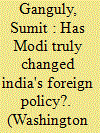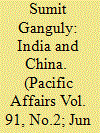|
|
|
Sort Order |
|
|
|
Items / Page
|
|
|
|
|
|
|
| Srl | Item |
| 1 |
ID:
153993


|
|
|
|
|
| Summary/Abstract |
The noted Indian foreign policy analyst, C. Raja Mohan, in a 2015 book, Modi's World: Expanding India's Sphere of Influence, argued that Prime Minister Narendra Modi had ushered in a “third republic” in terms of the conduct of India's foreign policy. His basic argument was that Modi had fundamentally reinvigorated India’s foreign policy, finally shedding many of the shibboleths that had previously hobbled the country's foreign policy choices. Among these, of course, was the hoary commitment to nonalignment and then its subsequent incarnation, “strategic autonomy.” He also contended that India was now in the process of dispensing with the visceral, reflexive anti-American streak that had long characterized its foreign policy.
|
|
|
|
|
|
|
|
|
|
|
|
|
|
|
|
| 2 |
ID:
159534


|
|
|
|
|
| Summary/Abstract |
Sino-Indian relations, which have long been fraught, took an especially adverse turn this summer with a military-to-military confrontation on the Doklam Plateau near the India-Bhutan-Tibet trijunction. After several weeks, Indian and Chinese forces withdrew from the region. However, neither side resiled from their respective territorial claims. This episode exemplified the troubles that have come to characterize the Sino-Indian relationship, especially since Prime Minister Modi assumed office in 2014. His regime, which is more nationalistic and reposes greater faith in the utility of force in international politics, had initially sought to diplomatically court the PRC in the hopes of improving their bilateral relationship. However, these efforts did not prove successful. Instead, the People’s Liberation Army, as in the past, continued to undertake limited probes along the Himalayan border, while the PRC continued to make diplomatic, commercial, and strategic inroads into India’s neighbours, trying to reduce India’s influence in those countries. The Modi regime, in turn, sought to counter these initiatives through various efforts of its own in the neighbourhood. Beyond South Asia, India has also sought to enhance its ties with Australia, Japan, the United States, and Vietnam in an attempt to hedge against the PRC’s growing economic and military assertiveness in Asia. These endeavours, however, have elicited hostile reactions from Beijing, which sees New Delhi as the only significant potential hurdle to the expansion of its influence in Asia. Despite Beijing’s adverse reactions it is unlikely that the current regime in New Delhi will scale back its efforts to cope with what it deems to be significant threats emanating from its behemoth northern neighbour.
|
|
|
|
|
|
|
|
|
|
|
|
|
|
|
|
|
|
|
|
|